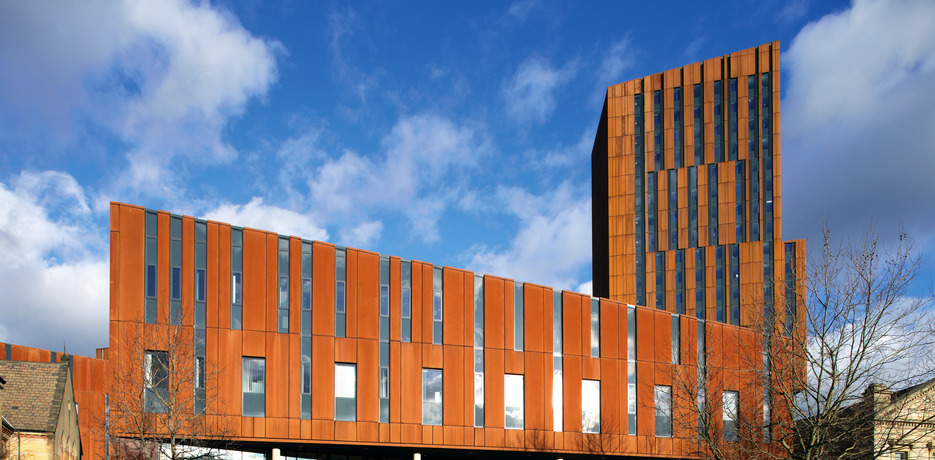Weathering steel
Weathering steel (also known by the trademark COR-TEN steel) is a form of high-strength, low alloy steel originally developed in the 1930's by United States Steel. It is a steel alloy, chemically composed to form a stable rust-like appearance that can resist corrosion and abrasion, by forming a protective surface layer, or patina.
The protective layer’s increased resistance is produced by the alloying elements and their particular distribution and concentration. When subjected to the influence of the weather, the protective surface layer continuously develops and regenerates, allowing the rust to form.
Weathering steel is often used in external sculptures, the most iconic of which is the Angel of the North in Gateshead. It can be used in bridges and other large structural applications, such as the New River Gorge Bridge, and it is becoming an increasingly popular design choice for buildings, often used alongside materials such as glass and terracotta. An example of such a building is the distinctive Broadcasting Tower in Leeds (see top image).
The advantages of weathering steel are that because it is already weathered and ‘rusted’, there are very low maintenance costs, it can be installed easily, and the need for a protective paint system is removed. Studies have found that bridges fabricated from unpainted weathering steel can achieve a design life of 120 years with only nominal maintenance, due to the low corrosion rate.
However, there are several challenges to weathering steel. It is unsuitable for use in marine or coastal environments, and in humid subtropical climates the patina may continue to corrode instead of stabilising into a protective layer. In addition, interface details require careful design as run-off water from wet rusted steel may negatively impact on other materials, such as staining glass. This is a particular problem in the first years after installation.
Special welding techniques or materials may be needed to ensure that weld-points weather at the same rate as the other materials.
[edit] Related articles on Designing Buildings
Featured articles and news
One of the most impressive Victorian architects. Book review.
Common Assessment Standard now with building safety
New CAS update now includes building safety questions as mandatory.
RTPI leader to become new CIOB Chief Executive Officer
Dr Victoria Hills MRTPI, FICE to take over after Caroline Gumble’s departure.
Social and affordable housing, a long term plan for delivery
The “Delivering a Decade of Renewal for Social and Affordable Housing” strategy sets out future path.
A change to adoptive architecture
Effects of global weather warming on architectural detailing, material choice and human interaction.
The proposed publicly owned and backed subsidiary of Homes England, to facilitate new homes.
How big is the problem and what can we do to mitigate the effects?
Overheating guidance and tools for building designers
A number of cool guides to help with the heat.
The UK's Modern Industrial Strategy: A 10 year plan
Previous consultation criticism, current key elements and general support with some persisting reservations.
Building Safety Regulator reforms
New roles, new staff and a new fast track service pave the way for a single construction regulator.
Architectural Technologist CPDs and Communications
CIAT CPD… and how you can do it!
Cooling centres and cool spaces
Managing extreme heat in cities by directing the public to places for heat stress relief and water sources.
Winter gardens: A brief history and warm variations
Extending the season with glass in different forms and terms.
Restoring Great Yarmouth's Winter Gardens
Transforming one of the least sustainable constructions imaginable.
Construction Skills Mission Board launch sector drive
Newly formed government and industry collaboration set strategy for recruiting an additional 100,000 construction workers a year.
New Architects Code comes into effect in September 2025
ARB Architects Code of Conduct and Practice available with ongoing consultation regarding guidance.
Welsh Skills Body (Medr) launches ambitious plan
The new skills body brings together funding and regulation of tertiary education and research for the devolved nation.
Paul Gandy FCIOB announced as next CIOB President
Former Tilbury Douglas CEO takes helm.
























